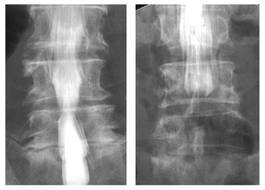 Having recently had my hip replaced, I found myself reflecting on my preparation for another surgery … on my neck. This was my experience with a strange test.
Having recently had my hip replaced, I found myself reflecting on my preparation for another surgery … on my neck. This was my experience with a strange test.
I was scheduled for what was called a myelogram. I quickly discovered it is a medical test of the invasive kind. It might well be called a “test with a lube.” Why “lube” you ask?
Well, as the two pages of instructions tell you—after receiving a local anesthetic, a standard lumbar puncture, better known as a “spinal tap,” is performed and contrast fluid or x-ray dye fills the area around the nerves of the lower back. It sounds like what my brother used call a “lube job” he needed for his car. They lubricate, luminate and laminate pictures of your spinal cord hoping to discover any foreign shapes or substances in that ever-so-tender nerve center of your body’s mainframe.
Neva, my wife, and I arrived at 6:35 a.m. and the receptionist greeted us with a “You must be Mr. Francis.” I was quickly processed and fitted with my testing apparel—a bare-back, pokey-dot hospital gown and light blue pair of surgery-room pants accented with my basic black, dress socks.
Not surprisingly, all the technicians and nurses did their preparation succinctly and professionally. There I lay on the concrete-like table, preliminary x-rays done, lower back shaved, cleaned and angled just right for the doctor. Upon arrival, he quickly told me his name and rattled off a brief explanation of his part in the testing procedure, which was basically, short and oddly painful. Short, in that he was only in the room for about 5 minutes and oddly painful, in that he seemed to be sticking my lower back with sharp knives and needles.
With doctor finished and out of the room almost unnoticed, we began a “Chinese-fire-drill”-like flurry of activity of x-rays from every conceivable angle. Working like a duo of trained Navy seals in combat frenzy, the two technicians chanted their commands with careful yet caring clarity. “Hold your breath,” “now breathe” was the chorus of the song they sang for the next few minutes as they hurriedly leaned, lowered and generally hung me from my toes to get not only the “fluid flowing,” but the timely picture of my now pressurized and illuminated spinal cord.
This part of the test ended with my body leaning head-first in a downward angle on the table, arms stretched forward and shoulders braced, chin resting on a folded cloth, looking straight ahead. That is when I was quickly transported back from patient to person. Looking ahead, braced solidly against the shoulder restraints and vulnerability of the last few moments, suddenly with chin on table, the Oriental technician (I honestly think his name was Larry or Harry) suddenly and softly began talking to me. His tone was careful and complete as he comforted me with a face-to-face encounter of the encouraging kind. From that moment on, even with the pressure of the fluid floating ominously around my central nervous system, I was confident we had made our way to the other side of worry.
From there we did the final stage of the procedure, a cat scan of the area in question. Uneventful compared to the previous encounter, I quickly found myself back in my corner of the processing room where I started. As my friend Larry elevated my legs and covered me with a blanket, I noticed a man sitting on a gurney across from me. Two things struck me about him: first, he was sitting up instead of lying down and second, he appeared apprehensive. I nodded as our eyes met and once alone he asked me if I had just had a myelogram. As I said, “Yes,” his demeanor changed from fearful to hopeful. He wanted to know what I had to say. Why? He wanted and needed to hear what I had to say not because he needed “advice,” but because he needed “news.”
Simply put, I had news. I had the truth about his soon-to-be experience. It was an experience sure to bring news—“good” news or “bad” news. And he needed to hear a word of news from someone who had not only been where he was going, but had survived to tell about it. He needed more than pat-on-the-back encouragement. He needed down-in-the-heart hope. So, there we were, two strangers resting on rolling beds pausing long enough to tell and hear—the news!
If we are followers of Christ, we have news. Not only do you have news, we have good news. So tell me, why is it that we are so reluctant to tell it?